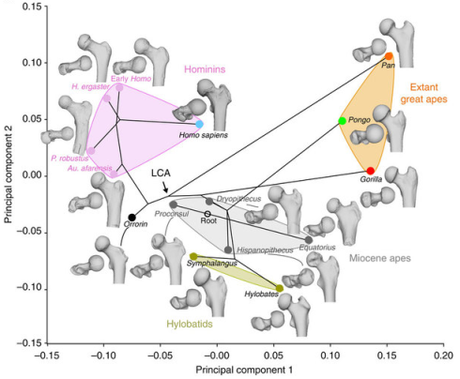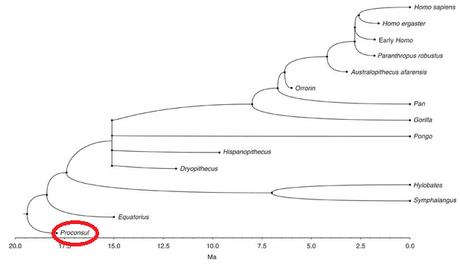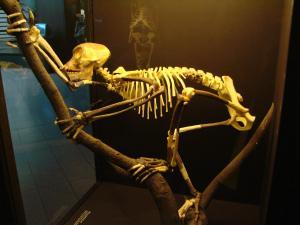There’s something of a paradox in the story of human evolution. Chimps are our closet living relatives and they knuckle-walk. Yet there’s no evidence of any of our ancestors ever knuckle-walking, which is what you might expect if we evolved from a chimp-like creature. In fact if you take a look at the earliest known human ancestor (which lived shortly after we diverged from chimps) the orientation of their spinal cord provides strong evidence they had an upright posture.
Since we only have the skull of this species, called Sahelanthropus tchadensis, we don’t know much about how they actually moved; except that it wasn’t like a chimp, their spinal orientation proves that. However, we do have some skeletal remains for a slightly younger species that lived ~6 million years ago (Sa. tchadensis & the chimp/human split being around 7 million years ago). It’s known as Orrorin tugenensis; and whilst we haven’t found a skull of theirs we have found some leg bones, so the species provides a great way to study how early humans were moving.
And a study published by an international team of authors (including some people from the Stony Brooks department whose chimps were at the center of a case to grant apes legal rights) does just that; comparing the femur of Orrorin to over 400 others; including living and fossil apes. They performed a principle component analysis of these bones, which is a fancy statistical technique that examines how similar they are too each other. Long, boring stats story short: the closer two species are to each other the chart, the more similar their femora. They then drew the consensus view of the family tree between these species on the chart, which allowed them to predict where the last common ancestor of humans and chimps should fall.

I already explained this in the post. If you’re just skipping through to look at the pretty pictures the shame on you
This graph tells us 2 things. First, that humans and chimps appear to have been evolving in opposite directions since we split, evolving unique methods of movement. This would explain why no fossil humans have been found with evidence of knuckle walking: it’s a recent development in the chimp lineage. Secondly, it notes that Proconsul has a femur very similar to that of the last common ancestor between humans and chimps (but that doesn’t mean it was the last common ancestor, just had a similar leg).
Proconsul is a genus of primates that lived ~25 million years ago in Africa. Now, Proconsul was once thought to be the common ancestor of apes; given it shared many features with them. However, since then new fossils have been found which appear to have been even more similar, prompting Proconsul to be relegated to a more distant branch of the ape family. But as this study shows, it may still have moved like the common ancestor of humans and chimps, despite this distant relationship.

The family tree of the species examined in this study. Proconsul is all on its lonesome
So, how did it move I hear you ask? Well, it was what’s known in fancy science words as a “pronograde arboreal quadruped” which basically means it had a horizontal body and climbed through the trees on all fours. I’ve even found a pretty picture of a reconstruction of Proconsul engaged in hardcore tree-on-primate action to help you , dear reader, visualise it.

Wikipedia can be really useful sometimes
But concluding the common ancestor also moved like this is based on the assumption that the similarities in their femora implies similar ways of moving. And that’s a fairly big assumption. Given we’re egocentric as a species and like studying our own evolution, we’ve identified some key traits in the femur that are strong evidence of a species moving bipedally. But no such “defining” characteristics have been linked to pronograde arboreal quadrupedalism (at least to my knowledge, but then I don’t spend much time looking at stuff >7 million years old).
And even if they have been, we haven’t actually found the femur of the last common ancestor to look for them. We’ve just got a prediction based on some statistics. Whilst this is a promising avenue of research that could shed a whole suns-worth of light on the evolution of our locomotion, there’s not yet enough to draw any real conclusions from it.
However, whatever follow-up research finds this study does prove one thing: human and chimp locomotion is evolving in opposite directions. But then, you already knew that didn’t you.
References
Almécija, S., Tallman, M., Alba, D. M., Pina, M., Moyà-Solà, S., & Jungers, W. L. (2013). The femur of Orrorin tugenensis exhibits morphometric affinities with both Miocene apes and later hominins. Nature communications, 4.
Ward, C. V. (1993). Torso morphology and locomotion in Proconsul nyanzae.American journal of physical anthropology, 92(3), 291-328.
Zollikofer, C. P., De Leon, M. S. P., Lieberman, D. E., Guy, F., Pilbeam, D., Likius, A., … & Brunet, M. (2005). Virtual cranial reconstruction of Sahelanthropus tchadensis. Nature, 434(7034), 755-759.

